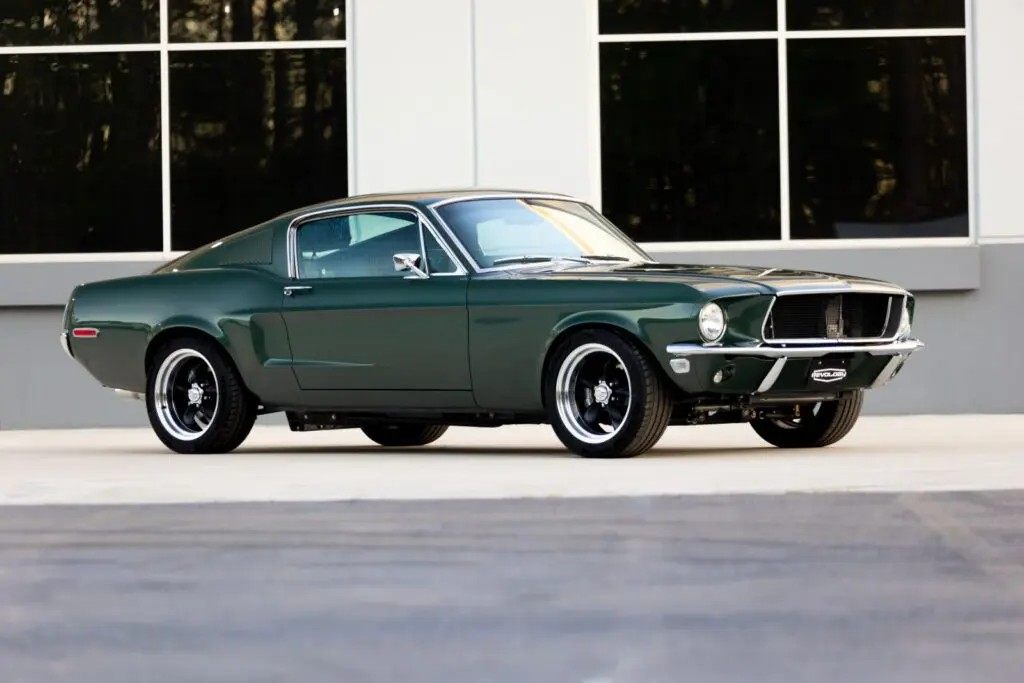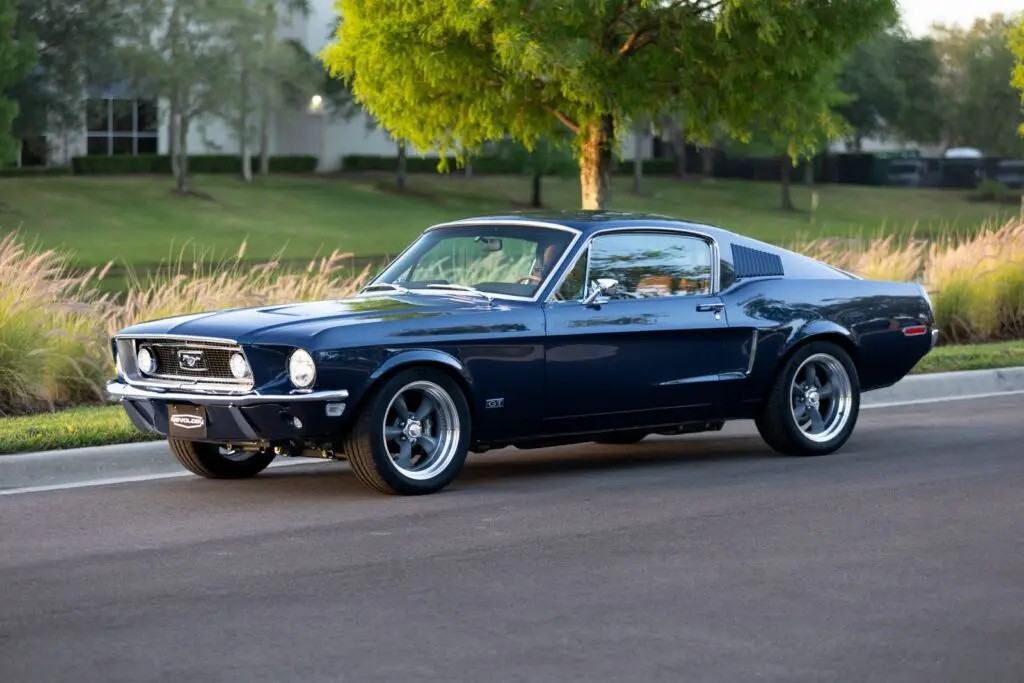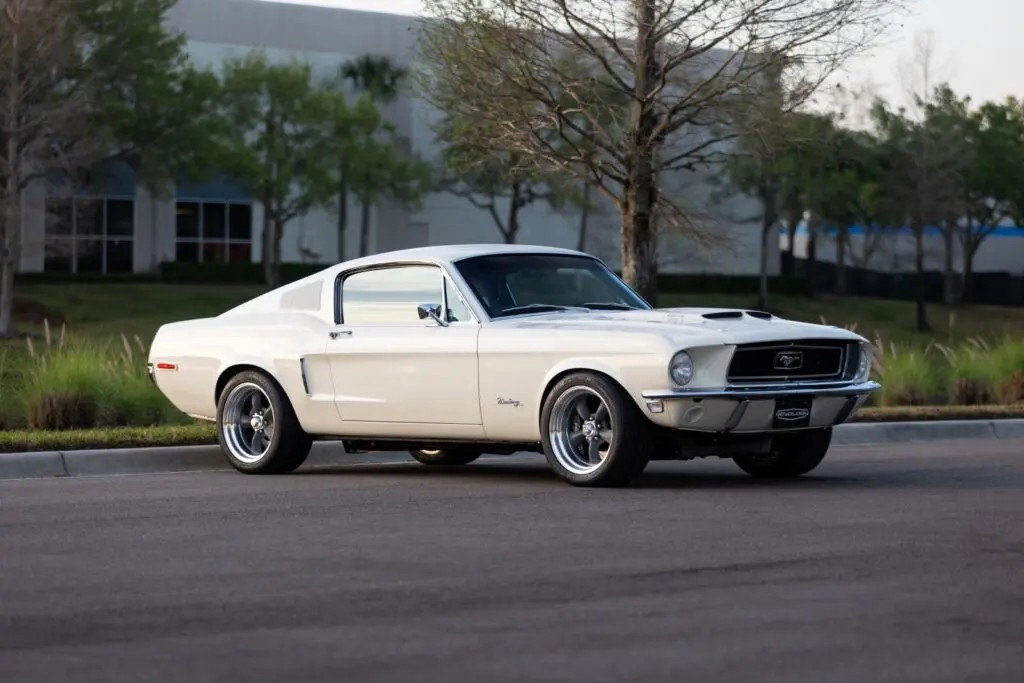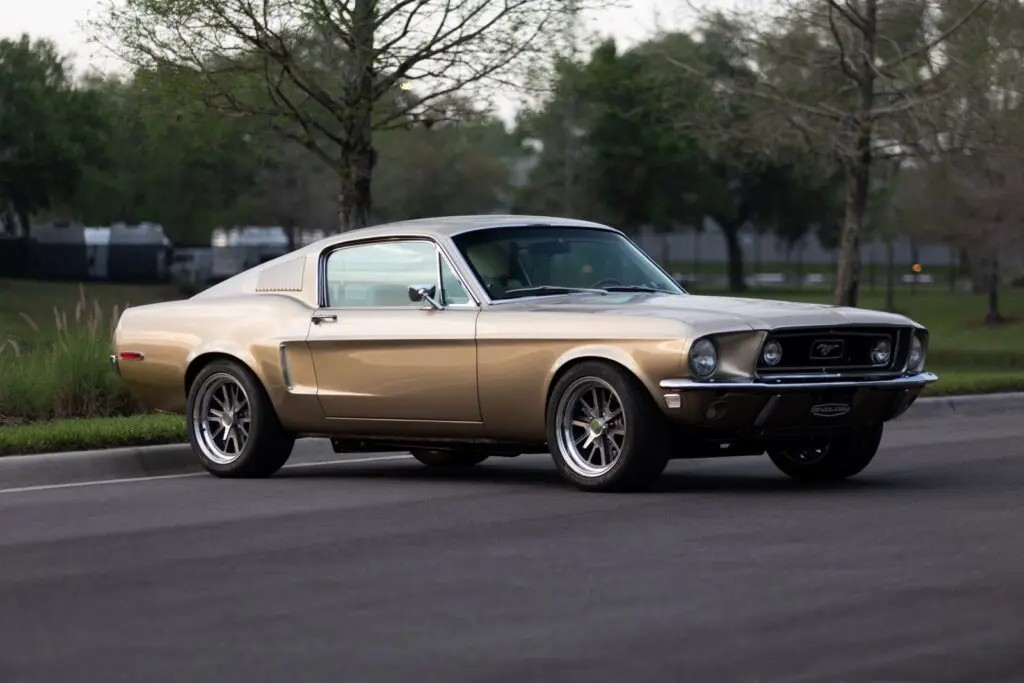
The 1968 and 1967 Ford Mustang GT models stand as iconic representations of American muscle cars, embodying the spirit of the late 1960s automotive revolution. Building upon the success of the original 1964 Mustang, Ford introduced the GT package in 1965, enhancing the vehicle’s performance and appeal. By 1967, the Mustang had evolved significantly, with the introduction of a larger body, more powerful engine options, and refined styling.
Their production numbers underscore the importance of the 1967 and 1968 Mustang GT models. In 1967, Ford produced a total of 472,121 Mustangs, with 24,078 units equipped with the GT/GTA package, highlighting the model’s popularity and the growing demand for performance-oriented vehicles. In 1968, production slightly decreased to 317,404 units, yet the 1968 Mustang GT timeless classic continued to capture the hearts of car enthusiasts.
This blog aims to provide classic car enthusiasts, collectors, and prospective buyers with an in-depth look at the 1967 and 1968 Mustang GT models. Let’s explore the key specs, design updates, performance highlights, and the historical influences that made these vehicles legendary,while placing them in the broader context of the evolution of the Mustang GT.
History of the 1967–1968 Mustang GT
The 1967–1968 Mustang GT models represent a pivotal chapter in the history of the Ford Mustang and the broader American muscle car era. When the original Ford Mustang debuted in 1964, it instantly captured public imagination with its sporty design, affordable price, and performance options.
Then the introduction of the GT package in these years marked a turning point for Ford, offering buyers a more performance-focused Mustang with enhancements such as disc brakes, dual exhausts, heavy-duty suspension, and distinct styling cues. These improvements reflected a growing demand for muscle cars, as enthusiasts sought vehicles that combined speed, handling, and aggressive design.
What makes the 1967–1968 GT models stand out in the Mustang timeline is not just the numbers but the innovations they introduced. These models featured new styling updates, larger engines, and enhanced handling, setting the stage for future high-performance variants and cementing their reputation among collectors and those who see the 1968 Mustang GT as a collector’s dream
Evolution from 1965-1966 to 1967-1968
The transition from the 1965–1966 Mustang models to the 1968–1967 Mustang GT classic models marked a significant leap in both design and performance. This reflected Ford’s strategy to keep pace with the intensifying muscle car wars of the late 1960s.
The 1965–1966 Mustangs retained a compact pony car profile with a 108-inch wheelbase and relatively narrow body dimensions. In 1967, Ford redesigned the Mustang to be longer, wider, and more aggressive, with a slightly stretched wheelbase (still 108 inches) but a wider track and overall increased length to accommodate larger engines.
The early Mustangs (1965–1966) topped out with the 289 cubic-inch V8, offering respectable performance for its time. In contrast, the 1967–1968 GT models could be equipped with big-block powerplants, including the 390 cubic-inch V8 and, in 1968, the legendary 428 Cobra Jet. Suspension improvements included heavier-duty springs, larger brakes, and GT-specific handling packages designed to enhance road control.
Ford’s redesign was a direct response to rising competition from muscle cars like the Chevrolet Camaro (introduced in 1966 for the 1967 model year) and the Pontiac Firebird. These rivals offered larger engines and more aggressive styling, prompting Ford to evolve the Mustang GT into a true muscle car contender rather than just a sporty coupe.
Key Features of the 1967-1968 Mustang GT
The 1967–1968 Mustang GT models stood out as the performance-focused variants of Ford’s popular pony car, blending muscular power with refined styling. Introduced at a time when the muscle car wars were heating up, the GT package added a combination of exclusive design elements, powerful engine choices, and upgraded handling features that elevated it above the standard Mustang.
These models came with unique GT badging, fog lamps integrated into the grille, dual exhaust with chrome quad tips, and heavy-duty suspension setups. The GT package could be paired with either coupe, convertible, or fastback body styles, and its appeal lay in the perfect balance of style and performance. In 1967, more than 28,800 Mustangs were equipped with the GT package, making it one of the most desirable trims for collectors today.
To fully appreciate the GT’s appeal, let’s break down its performance under the hood and styling enhancements.
Engine Options and Performance
The Mustang GT lineup offered several compelling V8 powertrains:
- 289 ci V8: This small-block delivered up to 271 hp, combining strong acceleration with manageable daily driving performance.
- 390 ci FE V8: Added in 1967, this big-block engine offered 320 hp and torque, hitting 0–60 mph in around 6.3 seconds, and was famously driven in the 1968 film Bullitt.
- 428 ci Cobra Jet (1968 only): Factory-rated at 335 hp (though dyno tests suggested closer to 400 hp), the Cobra Jet engine was a serious performance step. If offered low 14-second quarter-mile times and a top speed exceeding 120 mph (428 Cobra Jet performance).
Owners often pursue period-correct tweaks or best performance upgrades for the 1968 Mustang GT Cobra Jet to enhance drivability while preserving authenticity. GT models also came with front disc brakes, heavy-duty suspension, and a dual exhaust.
Design Changes and Styling Enhancements
The GT showcased a range of visual and functional upgrades aimed at signaling performance:
- Exterior Styling: The 1967 model featured a wider body with sculpted side panels, a larger hexagonal grille, and GT-specific fog lights. The 1968 version added federally mandated side marker lights for improved visibility.
- GT-Specific Touches: Features such as unique GT badges, optional racing stripes, and chrome trim around exhaust outlets immediately distinguished the GT trim package.
- Interior Enhancements: Available Deluxe interiors included brushed aluminum or wood-grain dash accents, five-gauge instrument clusters, center console, high-back bucket seats, and optional AM/FM stereos, adding both style and comfort to the performance experience.
These design tweaks helped Ford position the GT as not just a fast car, but a more refined, driver-focused machine in the competitive muscle car market.
Performance and Handling of the 1967–1968 Mustang GT

The 1967–1968 Mustang GT models elevated the driving experience far beyond that of the standard Mustang, offering a potent combination of powerful engines, upgraded suspension, better braking, and a road presence that embodied the muscle car era.
Below, let’s explore how these builds performed in everyday settings and during spirited drives.
Real-world and contemporary magazine tests consistently praised the GT’s performance: a 1967 GT equipped with the 390 V8 was recorded by Car and Driver and MotorTrend at a brisk 0–60 mph in about 7.3 seconds, with a quarter-mile time in the mid-15-second range. These figures earned the Mustang GT its reputation as a genuine muscle car, offering serious acceleration while remaining drivable.
Ride and Handling Improvements
Under the skin, the 1967–1968 Mustang GT received a firm suspension overhaul: heavy-duty coil springs, a thicker front stabilizer bar, and a solid rear axle equipped with larger shocks boosted stability in curves. Different reliable sources like MotorTrend remarked that, compared to its rivals, the Chevrolet Camaro and Pontiac Firebird, the GT offered more composed handling and less body lean.
The inclusion of front-disc brakes was particularly significant for stopping performance. Buyers could opt for the GT handling package, which included stiffer sway bars and shock absorbers, making the GT noticeably more controlled and agile than stock Mustangs of the era.
Fuel Economy and Daily Driving
Despite its muscle car status, the 1967 Mustang GT surprised drivers with reasonable fuel consumption for the era. Real-world owner data shows an average of around 13 mpg in mixed driving. Highway efficiency in small-block models (such as the 289 V8) sometimes reached 18–20 mpg during steady cruising.
Though heavy V8s like the 390 and 428 were less frugal, often averaging between 8 and 12 mpg, many owners accepted the higher consumption as part of the muscle-car experience.
1967-1968 Mustang GT Interior Features
Step inside the 1967–1968 Mustang GT and you’ll immediately notice a cabin that blends sporty flair with refined touches. Unlike the base Mustangs, the GT models offered upgraded materials, performance-oriented gauges, and bespoke trim accents that elevated the driving experience. Some standout features of the Mustang GT are,
- Upholstery & Materials: The features of the 1968 Mustang GT Fastback vinyl upholstery with optional deluxe upgrades, using high-quality “comfortweave” or faux woodgrain trim to add a refined feel to the cabin.
- Sporty Gauges and Badging: You’ll find recessed dual gauges (speedometer and tachometer) set within individual pods. These provide a racing-inspired cockpit feel. GT-specific emblems and trim matched its performance persona.
- Interior Trim & Steering: Many GT models had brushed aluminum or simulated wood dash panels, enhancing both style and elegance. Steering wheels also received performance orientation or deluxe options during this era.
These design details crafted a cabin atmosphere that was both engaging for drivers and emblematic of mid-century American muscle.
Upholstery and Customization Options
GT buyers were offered quite a range of customization to suit their personal style and comfort preferences:
- Deluxe Interior Packages: Upgraded interiors for the 1967–1968 Mustang GT went well beyond cosmetic changes. The brushed aluminum dash inserts gave the cockpit a sport-oriented, race-inspired look, while matching door panels with molded armrests improved both aesthetics and ergonomics. In specific GT models, a full-length center console was offered, providing storage compartments, padded trim, and chrome detailing that elevated the overall feel of the cabin.
- Seat Options: Buyers could opt for standard low-back bucket seats or deluxe high-back designs with more pronounced bolstering for improved support during spirited driving. The comfortweave vinyl option, a textured material that allowed better breathability, was especially popular among owners in warmer climates. Color choices ranged from classic black and parchment to bold hues like red, aqua, and ivy gold, giving owners a broad palette to match or contrast with the exterior.
- Brochure-Backed Details: Original Ford sales brochures and dealer order guides showcased just how far customization could go. Options included contrasting carpet colors, custom headliners, decorative steering wheel designs, and door panel variations that incorporated simulated woodgrain or chrome accents. These brochures highlighted Ford’s intent to market the GT as a muscle car with the personalization range of a luxury coupe.
Technology and Comfort Enhancements
While the Mustang GT was primarily a performance machine, Ford ensured that the 1967–1968 models offered a balance of comfort and modern features for the era:
Advanced Instrumentation: The GT models often came with a five-dial instrument cluster, replacing the more straightforward gauge layout of earlier Mustangs. These included a speedometer, tachometer, fuel gauge, oil pressure gauge, and ammeter, giving drivers precise, race-inspired readouts. The addition of backlit numbers improved nighttime visibility, while chrome bezels added a touch of upscale style.
Audio and Entertainment: Many GT buyers upgraded from the standard AM radio to an AM/8-track stereo system, which was cutting-edge for the late ’60s. This allowed owners to enjoy their favorite music on the go, whether cruising the highway or attending a local car meet. Some models also offered dual-speaker setups for improved sound quality.
Ventilation and Comfort Systems: Ford improved interior airflow with better dash-mounted ventilation controls and optional air conditioning systems that provided effective cooling without sapping too much engine power. For colder climates, high-output heater cores ensured quick cabin warm-up.
Luxury Touches: While still a muscle car at heart, the GT interior could be fitted with woodgrain appliqués, padded armrests, and chrome trim accents to create a more premium feel. Optional features like a tilt-away steering wheel for easier entry and exit, and adjustable driver’s seats for a better driving position, showed Ford’s commitment to making the GT appealing for both performance enthusiasts and comfort-focused buyers.
How to Identify a 1967-1968 Mustang GT

Because GT was an option package (not a standalone model), verifying authenticity matters. Cross-check VINs, engines, fog lamp wiring, rear valance cutouts, and interior equipment. For deeper context on authenticity pitfalls (and how restorers vet similar icons), many also review how to spot a real 1967 Shelby GT350 vs. replica
By carefully examining VIN data, original equipment specifications, and distinct design cues, both inside and out, you can confidently distinguish genuine GTs from replicas, preserving the legacy of one of the most iconic pony cars ever produced.
Some detailed tips to check whether it is a Mustang GT or not are,
1. VIN Decoding
The first step in authenticating a GT is to check the Vehicle Identification Number (VIN). In 1967 and 1968, the VIN was stamped on a metal plate riveted to the driver’s side dashboard (visible through the windshield) and also found on the warranty plate inside the driver’s door. Key points to look for:
- Engine Code: Genuine GTs will have VIN codes that correspond to higher-performance engines, such as the 390 cubic-inch V8 (“S” code in 1967, “S” or “R” (428 Cobra Jet) codes in 1968).
- Model Year & Plant Codes: The first digit confirms the year (7 = 1967, 8 = 1968), followed by the assembly plant code (e.g., F = Dearborn, R = San Jose).
- Body Style Code: Fastback (63A/63B), Convertible (76A/76B), or Hardtop (65A/65B).
You can verify VIN details with Mustang 1967–1968 VIN decoding charts.
2. Exterior Identification
Authentic GTs carried several unique exterior cues, such as:
- GT Gas Cap: Models came with a round “GT” logo gas cap instead of the standard Mustang emblem.
- Fog Lights: Factory-installed fog lamps mounted in the grille, wired into the headlight switch harness.
- GT Badging: Side fenders displayed “GT” emblems, and dual exhaust outlets exited through the rear valance with chrome quad tips.
- Styled Steel Wheels: Many came with 14-inch styled steel wheels with GT-specific center caps.
3. Interior and Performance Cues
Inside, genuine GTs often included:
- Five-Dial Instrument Cluster: Standard on GTs for better performance monitoring.
- GT-Specific Trim Packages: Deluxe interior upgrades, including brushed aluminum or woodgrain dash inserts.
- Performance Equipment: Heavy-duty suspension, front disc brakes, and dual exhaust, all of which came factory-installed.
4. Authentication Tips & Avoiding Misidentification
Because GT packages were dealer-orderable and many parts can be swapped, it’s common to find standard Mustangs dressed up to look like GTs. To avoid buying a clone:
- Cross-check VIN engine codes with the car’s current engine.
- Look for factory fog lamp wiring harnesses, not aftermarket splices.
- Inspect the rear valance panel for original quad exhaust cutouts rather than recently cut replacements.
For a detailed breakdown, you can consult Mustang GT authentication guides, which provide original factory specs, diagrams, and restoration tips.
Common Misidentifications
Identifying a genuine 1968–1967 Mustang GT for sale can be tricky. Over the years, many standard Mustangs have been modified to look like GTs, either as personal projects or to increase resale value. While some of these “tribute builds” are high quality, they can still be spotted with the proper knowledge.
- Incorrect Badge Placement: Original GT badges were mounted in precise factory locations, typically on the lower front fenders behind the wheel openings. Spacing, alignment, and angle were consistent across all factory cars. On many clones, badges sit too high, too low, or slightly off-angle, which can be an immediate red flag.
- Non-Original Fog Lights: The GT package included grille-mounted fog lamps that followed Ford’s specific size, bracket, and wiring standards. Many replicas use modern aftermarket lights or incorrect brackets, which often look “off” when compared to original factory parts.
- Exhaust System Differences: True GTs left the factory with dual exhausts exiting through the rear valance, complete with chrome-trimmed cutouts. If the cutouts are missing, poorly aligned, or the tips extend too far out, it may indicate a non-original setup or a replaced valence panel.
- Wheels and Trim Confusion: Styled steel wheels and deluxe interior touches, such as unique dash inserts and performance gauges, are sometimes retrofitted onto non-GT models. While they enhance the appearance, they don’t confirm GT authenticity without the matching mechanical and factory documentation.
Always make sure to double-check these details, ideally with factory records or an expert inspection, to avoid costly mistakes and ensure you’re getting a genuine GT.
Must-Have Restoration Tips for 1967-1968 Mustang GTs

Restoring a 1967–1968 Mustang GT for sale is both a rewarding project and a careful balancing act. These cars are iconic for their mix of raw muscle and stylish refinement, and a good restoration preserves that original character while allowing for thoughtful upgrades.
The best results come from respecting the car’s factory specifications, sourcing authentic parts where possible, and integrating performance improvements that enhance reliability and drivability. Whether you’re working on a weekend project or a complete frame-off restoration, focusing on the right areas will ensure your GT not only looks stunning but also performs as it did, or even better.
Restoring Classic Engines
For many Mustang GT enthusiasts, the heart of the restoration lies under the hood. The 1967–1968 GTs came with a range of V8 powerplants, from the high-revving 289 cubic inch to the potent 390 FE big block. The first step in any engine restoration is careful inspection, checking for cracks, wear, and internal damage to determine if a rebuild or replacement is necessary.
When aiming to maintain originality, sourcing OEM-spec components is key. This includes correct pistons, camshafts, and carburetor setups, which not only preserve authenticity but also protect resale value. However, minor modern upgrades can improve reliability without compromising originality. For example, switching to hardened valve seats for unleaded fuel, upgrading to electronic ignition for better spark consistency, or using modern gaskets to prevent leaks.
Proper documentation is also essential. Retaining the original engine block, verified by matching VIN stamps, is a significant factor in maintaining the GT’s value. If you must replace parts, consider keeping the originals stored safely for future reference.
Upgrading the Suspension and Handling
While the factory suspension of the late-’60s Mustang GT delivered respectable performance for its era, modern roads and driving expectations call for some careful improvements.
However, owners who plan to drive their GT regularly may consider subtle upgrades that improve ride quality and safety without altering the car’s appearance. Popular enhancements include modern gas-charged shocks for better damping, polyurethane bushings for sharper handling, and enhanced steering components to reduce play in the wheel.
When restoring, attention to detail matters. Factory-correct finishes, hardware, and alignment specs help maintain the original appearance, while quality aftermarket components ensure the car handles confidently in modern traffic. Done right, these suspension upgrades will give your GT a planted, responsive feel while preserving its classic muscle car soul.
Cost of Owning and Restoring a 1967–1968 Mustang GT

Owning a genuine 1967–1968 Mustang GT is both a passion and an investment, but understanding the complete financial picture is essential before diving in. Depending on condition, a project car needing complete restoration can cost anywhere from $12,000 to $25,000, while fully restored, show-quality examples often sell for $55,000 to $85,000 or more.
Beyond the purchase price, annual ownership costs, including insurance, maintenance, storage, and fuel, can add $1,500 to $4,000 per year, making it essential for buyers to budget for both restoration expenses and ongoing upkeep.
Whether you’re reviving a barn find or acquiring a pristine GT, knowing the cost breakdown helps set realistic expectations.
Restoration Costs
Restoring a 1967–1968 Mustang GT involves three major cost categories: engine and drivetrain, bodywork and paint, and interior refurbishment. Here’s a realistic breakdown based on current market data:
- Engine & Drivetrain Rebuild – A period-correct V8 rebuild, including machining, new pistons, crankshaft work, camshaft, and carburetor tuning, typically costs between $4,500–$8,000, depending on the level of performance upgrades. Transmission overhauls can add another $1,500–$3,000.
- Bodywork & Paint: This is often the single most significant expense. Rust repair, panel replacement, and a high-quality paint job can range from $8,000–$10,000. Rare factory colors or concours-level finishes can increase the cost.
- Interior Restoration: Restoring GT-specific interior trim, vinyl upholstery, dash components, and gauges generally costs $2,500–$6,000, especially if sourcing authentic reproduction parts from suppliers like CJ Pony Parts or Mustangs Unlimited.
When factoring in miscellaneous costs, brake overhauls, suspension work, chrome refinishing, electrical rewiring, full restorations can easily total $20,000–$40,000, excluding the purchase price of the car.
Value and Investment Potential
The good news for collectors is that 1967–1968 Mustang GTs have consistently appreciated over the past two decades. According to Hagerty’s valuation tools, well-restored GT models often command $55,000–$85,000, with concours-condition cars fetching over $100,000 at auctions.
From an investment standpoint, buying a fully restored example often makes more financial sense than a ground-up restoration, unless you already own the car or place a high value on the restoration process itself protecting that investment comes down to maintaining classic Mustang GT long-term value
FAQs
How much does a 1967–1968 Mustang GT cost today?
Prices vary widely based on condition, originality, and rarity. A project car needing complete restoration can start around $18,000–$25,000, while fully restored or well-preserved originals often range from $55,000 to over $100,000. Rare configurations such as big-block engines or special editions can fetch significantly higher prices at auctions.
What are the most common problems with 1967–1968 Mustang GTs?
Owners often face rust issues in the floor pans, frame rails, and lower body panels, along with engine wear from decades of use. Suspension components may be worn or outdated, and factory drum brakes may need upgrading for modern driving safety. Electrical issues, especially with original wiring harnesses, are also common.
How do I know if my Mustang is an original 1967–1968 GT model?
Authenticating a GT requires checking the VIN, door data plate, and factory build sheet (if available). Look for original GT-specific features like fog lights in the grille, dual exhaust with chrome quad tips, front disc brakes, and GT badging. Beware of “clones” where badges and trim have been added to a non-GT model.
What is the difference between the 1967 Mustang GT and the 1968 Mustang GT?
The 1968 GT featured minor styling changes, including a revised grille, new side marker lights (due to federal safety regulations), and updated interior trim options. The 1968 model also introduced new engine options, including the 428 Cobra Jet, offering a noticeable boost in performance over 1967’s lineup.
Turn Your Mustang Dream into A Reality

The 1967–1968 Mustang GT remains one of the most celebrated icons in muscle car history. It blends timeless design, thrilling performance, and genuine collector value. Whether you’re drawn to its historical significance, its unmistakable style, or the joy of bringing one back to life, owning a GT from this golden era is as rewarding as it is exciting.
If you’re considering investing in one of these classics, take the time to research authentic models, understand restoration costs, and plan for ongoing maintenance to protect your investment. Whether you’re hunting for a barn find to restore or a fully rebuilt showpiece, the Mustang GT offers both a connection to the past and a driving experience that still turns heads today.
Ready to take the next step? Explore Revology Cars, connect with restoration experts, and start your journey toward owning a piece of American automotive legend.